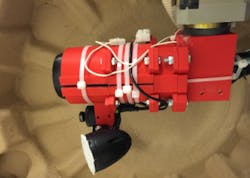Robot and machine vision aid silicon solar cell manufacture
Perfecting the manufacture of monocrystalline silicon (the material that forms the basis of most photovoltaic panels) has been preoccupying the research community at SINTEF (Trondheim, Norway) for many years. The researchers have now focused their attention and, more to the point, that of their sensors on the important quartz crucible that plays one of the key roles in the manufacture of solar cells. They have developed an optical-sensor-laden robot to better inspect these crucibles.
Quartz crucible characteristics
These quartz crucibles are between 50 and 70 cm in diameter with walls about 1 cm thick. The quality of a crucible is very important. If it is inadequate, the end product will be unusable. The crucible is built up of different quartz layers that perform a variety of functions during the manufacturing process. It acts as a container used in the furnaces that melt silicon prior to the production of monocrystalline silicon.
As part of this process, a seed silicon crystal is dipped into the molten silicon and a large monocrystalline silicon crystal is then withdrawn from the melt. This crystal withdrawal process takes up to two days. The end product is an approximately 2-m-long and 20-cm-wide crystal which in turn is used as the raw material for the manufacture of the silicon wafers that eventually become solar cells.
"The better the raw materials we have, the more efficient the solar cells will be, and this in turn will reduce the environmental footprint of the electricity the cells generate," says Bones. "So it's important that the quartz crucibles we use are of the highest quality. Currently, quality assurance of the crucibles is carried out by visual inspection, but this has its limitations."
Crucible inspector
A crucible-inspecting robot has been developed by SINTEF researchers and a group of students at NTNU; it includes a number of optical sensors that can detect much more than is visible to the human eye.
Quartz crucibles are built up of different layers with varying structures that combine reflectivity and transparency. To reveal a crucible's properties, faults and defects it is necessary to search in depth.
"Before we built this robot we studied crucibles in order to identify the connection between their quality and the properties of the monocrystalline silicon end product," says Bones. "To do this we had to be quite brutal. We applied what are quite simply called destructive methods. This means crushing, grinding, up and dissolving the materials in chemicals. Subsequent analyses gave us clear indications as to the properties of the different layers that should make up a given crucible."
But now the researchers have taught the robot to nondestructively recognize defects in crucibles. SINTEF's new robot enables a crucible to be guided through a rapid and very accurate sorting process before it is used in the melt furnace. Here it plays one of the main roles in the crystal withdrawal process that precedes wafer manufacture. "Using a crucible with the wrong properties may result in having to re-melt the manufactured silicon," notes Bones.
Finding a single sensor that could do everything that the researchers wanted proved to be impossible, so they combined a selection of sensors and enabled them to communicate with each other. According to Bones, the confocal white-light sensor is one of the most important included in this system. It functions by responding to the different colours and corresponding wavelengths in the white light spectrum (see the illustration).
Among other things, a high-resolution digital CCD camera is also included that can see at very detailed scales. This in turn is connected to a machine-vision device that enables the system to identify small variations in materials that should not be there. The robot then locates itself in the correct physical position.
"Among the things we're measuring is the curvature and thickness of the quartz crucible, which is bowl-like in shape," says Bones. "Here, the robot has to adjust its 'eyes' at the correct angle for all the points it is programmed to inspect. This is made possible using several distance sensors and by carrying out calculations that permit the robot continuously to correct the track along which it moves."
Interest in sharing the technology
"Much of what we've achieved here is transferable to other processes and raw materials," says Bones, who is interested in sharing the technology with other project developers.
Source: https://www.sintef.no/en/latest-news/robot-vision-makes-solar-cell-manufacture-more-efficient/
About the Author
John Wallace
Senior Technical Editor (1998-2022)
John Wallace was with Laser Focus World for nearly 25 years, retiring in late June 2022. He obtained a bachelor's degree in mechanical engineering and physics at Rutgers University and a master's in optical engineering at the University of Rochester. Before becoming an editor, John worked as an engineer at RCA, Exxon, Eastman Kodak, and GCA Corporation.

